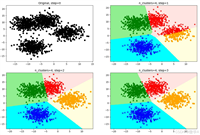1.背景介绍
1. 背景介绍
自然语言处理(nlp)是计算机科学和人工智能领域的一个分支,研究如何让计算机理解和生成人类语言。情感分析(sentiment analysis)和情感检测(sentiment detection)是nlp中的一个重要领域,旨在识别文本中的情感倾向。
情感分析和情感检测的应用非常广泛,例如评价系统、社交媒体监控、客户反馈分析等。随着人工智能技术的发展,这些技术在各种领域得到了广泛应用。
2. 核心概念与联系
在自然语言处理中,情感分析和情感检测是相关但不完全等同的概念。情感分析通常指的是对文本中情感倾向的全面分析,包括情感类型、强度等。情感检测则更关注对文本中情感倾向的二分类,例如正面、负面、中性等。
在本文中,我们将关注情感分析和情感检测的核心概念、算法原理、最佳实践以及实际应用场景。
3. 核心算法原理和具体操作步骤及数学模型公式详细讲解
情感分析和情感检测的核心算法原理主要包括以下几种:
- 词汇统计法
- 机器学习法
- 深度学习法
3.1 词汇统计法
词汇统计法是一种基于词汇频率的方法,通过计算文本中正面、负面、中性词汇的出现次数,从而判断文本的情感倾向。
具体操作步骤如下:
- 构建词汇表,包括正面词汇、负面词汇和中性词汇。
- 对文本进行分词,统计每个词汇在文本中出现的次数。
- 计算文本中正面、负面、中性词汇的出现次数之和,得到情感分数。
- 根据情感分数判断文本的情感倾向。
3.2 机器学习法
机器学习法是一种基于训练模型的方法,通过对大量标注的文本数据进行训练,从而建立情感分析模型。
具体操作步骤如下:
- 收集和标注大量的情感标记文本数据。
- 对文本数据进行预处理,包括分词、词性标注、停用词去除等。
- 选择合适的机器学习算法,如支持向量机、随机森林、朴素贝叶斯等。
- 训练模型,并对测试数据进行评估。
- 根据模型预测结果判断文本的情感倾向。
3.3 深度学习法
深度学习法是一种基于神经网络的方法,通过训练深度神经网络,从而建立情感分析模型。
具体操作步骤如下:
- 收集和标注大量的情感标记文本数据。
- 对文本数据进行预处理,包括分词、词性标注、停用词去除等。
- 构建深度神经网络,如卷积神经网络(cnn)、循环神经网络(rnn)、transformer等。
- 训练模型,并对测试数据进行评估。
- 根据模型预测结果判断文本的情感倾向。
4. 具体最佳实践:代码实例和详细解释说明
4.1 词汇统计法实例
```python import re from collections import counter
构建词汇表
positivewords = ["好", "喜欢", "棒", "很好"] negativewords = ["不好", "不喜欢", "坏", "很差"] neutral_words = ["没有什么特别的", "普通", "一般"]
对文本进行分词
def tokenize(text): return re.findall(r'\w+', text.lower())
统计词汇出现次数
def countwords(words): positivecount = 0 negativecount = 0 neutralcount = 0 for word in words: if word in positivewords: positivecount += 1 elif word in negativewords: negativecount += 1 elif word in neutralwords: neutralcount += 1 return positivecount, negativecount, neutral_count
计算文本情感分数
def sentimentscore(positivecount, negativecount, neutralcount): totalcount = positivecount + negativecount + neutralcount if totalcount == 0: return 0 return (positivecount - negativecount) / totalcount
判断文本情感倾向
def sentimentlabel(sentimentscore): if sentimentscore > 0.5: return "正面" elif sentimentscore < -0.5: return "负面" else: return "中性"
主程序
text = "我觉得这个电影很好,真的很棒!" words = tokenize(text) positivecount, negativecount, neutralcount = countwords(words) sentimentscore = sentimentscore(positivecount, negativecount, neutralcount) sentimentlabel = sentimentlabel(sentimentscore) print(f"情感分数: {sentimentscore}, 情感倾向: {sentimentlabel}") ```
4.2 机器学习法实例
```python from sklearn.featureextraction.text import countvectorizer from sklearn.modelselection import traintestsplit from sklearn.svm import svc from sklearn.metrics import accuracy_score
训练数据
data = [ ("我觉得这个电影很好,真的很棒!", "positive"), ("我觉得这个电影很糟糕,真的很坏!", "negative"), ("我觉得这个电影没有什么特别的,一般的", "neutral"), # ... ]
预处理
def preprocess(text): return re.sub(r'\w+', ' ', text.lower())
构建词汇表
def build_vocabulary(data): vocabulary = set() for text, label in data: vocabulary.update(preprocess(text).split()) return vocabulary
训练模型
def trainmodel(vocabulary, data): vectorizer = countvectorizer(vocabulary=vocabulary) x = vectorizer.fittransform([text for text, label in data]) y = [label for text, label in data] xtrain, xtest, ytrain, ytest = traintestsplit(x, y, testsize=0.2, randomstate=42) clf = svc(kernel='linear') clf.fit(xtrain, ytrain) return clf, vectorizer
主程序
vocabulary = buildvocabulary(data) clf, vectorizer = trainmodel(vocabulary, data)
对测试数据进行评估
xtest = vectorizer.transform(["我觉得这个电影很好,真的很棒!", "我觉得这个电影很糟糕,真的很坏!", "我觉得这个电影没有什么特别的,一般的"]) ytest = ["positive", "negative", "neutral"] ypred = clf.predict(xtest) print(f"准确率: {accuracyscore(ytest, y_pred)}") ```
4.3 深度学习法实例
```python import tensorflow as tf from tensorflow.keras.preprocessing.text import tokenizer from tensorflow.keras.preprocessing.sequence import pad_sequences from tensorflow.keras.models import sequential from tensorflow.keras.layers import embedding, lstm, dense
训练数据
data = [ ("我觉得这个电影很好,真的很棒!", "positive"), ("我觉得这个电影很糟糕,真的很坏!", "negative"), ("我觉得这个电影没有什么特别的,一般的", "neutral"), # ... ]
预处理
def preprocess(text): return re.sub(r'\w+', ' ', text.lower())
构建词汇表
def build_vocabulary(data): vocabulary = set() for text, label in data: vocabulary.update(preprocess(text).split()) return vocabulary
构建词汇索引
def build_index(vocabulary, data): index = {word: idx for idx, word in enumerate(vocabulary)} return index
训练模型
def trainmodel(index, data): tokenizer = tokenizer(numwords=len(index)) tokenizer.fitontexts([text for text, label in data]) x = tokenizer.textstosequences([text for text, label in data]) x = padsequences(x, maxlen=100, padding='post') y = [label for text, label in data] model = sequential() model.add(embedding(len(index), 128, inputlength=100)) model.add(lstm(64)) model.add(dense(3, activation='softmax')) model.compile(loss='categorical_crossentropy', optimizer='adam', metrics=['accuracy']) return model, tokenizer
主程序
vocabulary = buildvocabulary(data) index = buildindex(vocabulary, data) model, tokenizer = train_model(index, data)
对测试数据进行评估
xtest = tokenizer.textstosequences(["我觉得这个电影很好,真的很棒!", "我觉得这个电影很糟糕,真的很坏!", "我觉得这个电影没有什么特别的,一般的"]) xtest = padsequences(xtest, maxlen=100, padding='post') ytest = ["positive", "negative", "neutral"] ytest = tf.keras.utils.tocategorical(ytest, numclasses=3) ypred = model.predict(xtest) print(f"准确率: {tf.reducemean(tf.cast(tf.argmax(ypred, axis=-1) == tf.argmax(ytest, axis=-1), tf.float32))}") ```
5. 实际应用场景
情感分析和情感检测的应用场景非常广泛,例如:
- 评价系统:评价商品、服务、电影等。
- 社交媒体监控:监控用户在社交媒体上的情感倾向,发现违规信息。
- 客户反馈分析:分析客户反馈信息,提高客户满意度。
- 人工智能对话系统:构建更智能的对话系统,更好地理解用户的情感。
- 广告营销:根据用户情感倾向,提供更有针对性的广告推荐。
6. 工具和资源推荐
- nltk(natural language toolkit):一个python自然语言处理库,提供了许多常用的文本处理和语言模型功能。
- spacy:一个高性能的自然语言处理库,提供了许多预训练的语言模型,用于情感分析等任务。
- tensorflow:一个流行的深度学习框架,提供了许多高级的自然语言处理模型,如bert、gpt等。
- hugging face transformers:一个开源的nlp库,提供了许多预训练的transformer模型,如bert、gpt、roberta等。
7. 总结:未来发展趋势与挑战
自然语言处理中的情感分析与情感检测已经取得了显著的进展,但仍存在挑战:
- 语言多样性:不同语言、地区、文化背景等因素导致语言表达方式的差异,需要更多的多语言和跨文化研究。
- 语境理解:情感表达通常受到语境影响,需要更强的语境理解能力。
- 微观情感:目前的研究主要关注宏观情感,如正面、负面、中性等,但微观情感(如愉悦、沮丧、愤怒等)更能反映人们的真实情感。
- 数据不足:情感分析任务需要大量的标注数据,但标注数据收集和标注工作量大,需要更有效的数据收集和标注方法。
- 模型解释性:深度学习模型的黑盒性限制了模型解释性,需要更多的解释性模型和解释性方法。
未来,情感分析与情感检测将继续发展,涉及更多领域应用,并解决更多挑战。




发表评论